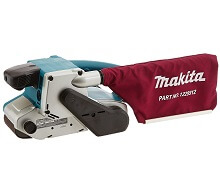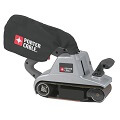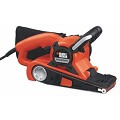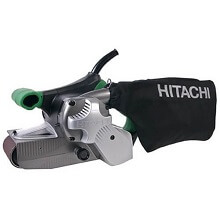User Review
( vote)Making a perfect finish on any treated surface is of paramount importance to create an impression at first glance. for this you will need one of the best belt sanders around.
For many years people have resorted to other types of sanders, which have recently been diluted by the emergence of innovative belt sanders.
There are plenty of benefits associated with the belt sanders and I will unfold them in my reviews below.
Now the use of the belt sanders has proven to be indispensable, particularly to professional technicians such as carpenters and woodworkers.
| Model | Image | Reviews | Buy It Now |
|---|---|---|---|
| Makita 9903 | 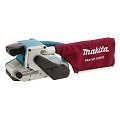 | Full Review | Buy Now |
| PORTER-CABLE 362V | 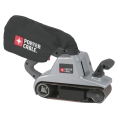 | Full Review | Buy Now |
| Black & Decker DS321 | 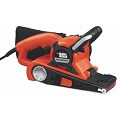 | Full Review | Buy Now |
| PORTER-CABLE 371 | 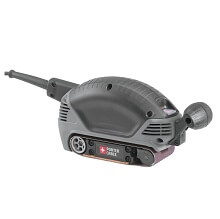 | Full Review | Buy Now |
| Hitachi SB8V2 | 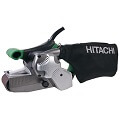 | Full Review | Buy Now |
There are literally hundreds of belt sanders in the market today, some of which cost exorbitantly.
Best Belt Sanders Reviews
In the reviews below, I have compiled a useful guide about the best belt sanders under $230 (top 5 sanders) characterized by sophisticated features.
I’ve also discussed the tips on what to look for when purchasing these powerful industrial tools and also how to use them to exercise precautionary safety measures.
Makita 9903 8.8 Amp 3-Inch-by-21-Inch Variable Speed Belt Sander with Cloth Dust Bag
Equipped with a powerful 8.8 AMP motor, Makita’s 9903 belt sander is one of the best in the industry.
The sander is characterized by its low noise rated at 85dB to prevent the damage to the operator’s ears.
This low noise is actually one of the selling points because plenty of machines are noisy.
The other attribute of this belt sander is the auto-tracking belt system to make sure that you achieve the highest accuracy in your sanding projects.
The sanding job will be completed quicker and efficiently with the variable speed control of between 690-1440 ft/min while the user keeps controlling the sander with its front grip design.
While operating this sander, the working area will be kept clean by the embedded dust bag to reduce your exposure to dust particles and also speed up your progress.
The nose is also designed to help get rid of the flush sanding.
In your package you will find the abrasive belt, dust bag and the sander.
 Jerry's Take
Jerry's TakeMakita 9903 belt sander outperforms other belt sanders with its low noise operations and auto-tracking belt system.
What the carpenter or furniture manufacturer wants is a performing tool that produces less sound.
Moreover, the sander’s versatility of sanding a variety of rough surfaces that include the metals and woods is a great attribute that intrigues many customers.
>> Click here to see pricing, ratings, and reviews on Amazon.com. <<
PORTER-CABLE 362V 4-Inch by 24-Inch Variable Speed Belt Sander
With Porter-Cable belt sander, you are assured a powerful belt sander equipped with a powerful 12 AMP motor to complete the sanding job efficiently and professionally.
If you have a woodwork project, this sander could be an ideal solution to complete large projects at a variable speed rating from 1000 to 1500 SFPM.
Moreover, you can vary the belt grit levels throughout your sanding projects using the quick-release belt-change lever.
Horizontal and vertical surfaces are smoothened with ease with this sander.
The design of the Porter-Cable 4 X 24 inch belt sander is purely metal to enhance its durability throughout.
The integrated belt tracking knob helps in the adjustment of the belt, while the large-capacity dust bag keeps sweeping away the dust for a cleaner working environment.
The belt also features comfortable handles for ease of operation.
With all these features encompassed, no woodworking projects will be seemingly impossible to fulfill.
Even the amateur can operate this belt sander by following the user manual included.
 Jerry's Take
Jerry's TakeThis Porter-Cable belt sander is of top-notch quality compared to others.
Its 12 AMP powerful motor has won my heart.
Just beware of operating it particularly on soft wood.
Refrain from pressing it too hard on the surface being treated because the end results might not be satisfactory.
The sander’s weight is sufficient to provide balance to whichever belt grit used.
>> Click here to see pricing, ratings, and reviews on Amazon.com. <<
Black & Decker DS321 Dragster 7 Amp 3-Inch by 21-Inch Belt Sander with Cloth Dust Bag
The Black & Decker DS321 Dragster belt sander is a great industrial tool below $100.
It is such a portable sander with dimensions 3 X 21 inch and a relatively powerful motor at 7 AMP.
It is outshone by the aforementioned belt sanders.
Nevertheless, it still provides the best of belt sanding, especially with its front roller that enables sanding in the tight corners of your surface.
The belt release lever allows you to quickly change the belt to avoid longer pauses amid your work.
Furthermore, the belt will remain intact in its position due to the belt adjustment knob featured.
To easily operate this belt sander, it comes with a 3 position handle as well as the dust collector bag to remove excessive dust debris. If you plan on revamping your home floors or remove old paint residues, this belt sander could be ideal for you. It is compact and lightweight.
 Jerry's Take
Jerry's TakeThe Black & Decker belt sander comes with the pre-installed 60 grit belt.
To me that is enough to sand rough surfaces, although not too fine.
If you want to apply a smooth finish on your smooth wood, you may want to have the higher grit belt, say 150 grit.
But for old paint or rust removal this belt sander can be quite efficient with the 60 grit belt.
All the other features make it attractive and a great value for money.
>> Click here to see pricing, ratings, and reviews on Amazon.com. <<
Hitachi SB8V2 9.0 Amp 3-Inch-by-21-Inch Variable Speed Belt Sander with Trigger Lock and Soft Grip Handles
Hitachi SB8V2 variable speed belt sander incorporates the powerful 9 AMP motor to execute the toughest sanding jobs.
The belt sander will last you for many years with its wear resistant V-belt.
All you have to do is to quickly change the belt whenever it frays or after every application.
It has a variable speed adjustment from 820 to 1475 ft/min.
The sander cold be easily operated with its soft elastomer grip surface and the ergonomic handles.
Meanwhile, the dust, rust or steel residues will be collected by the dust collector bag located at the left-hand side for efficient sanding at the corners.
The manufacturer has engineered this industrial tool for perfection and durability.
If there’s any factory fault, there is a 5-year warranty granted.
In a meantime you can enjoy a variety of applications such as metalwork, woodwork, drilling or carpentry with your newly bought belt sander.
 Jerry's Take
Jerry's TakeThe Hitachi robust design and rubberized hand grip are never a disappointment for the enthusiasts in hands-on operations.
It’s in fact a good value of investment to provide an excellent finish to a variety of surfaces.
The belt sander has all the features you would expect from a good sander that include belt tracking to keep it in position as well as the variable speed.
It is furthermore not as noisy as other industrial tools of the same caliber.
>> Click here to see pricing, ratings, and reviews on Amazon.com. <<
PORTER-CABLE 371 2-1/2-Inch by 14-Inch Compact Belt Sander
Porter-Cable has always been renowned for its production of quality industrial tools in the sanding niche.
This Porter-Cable 371 belt sander, in particular, comes with incredible features that include the textured rubberized grip for a comfortable handling.
Vertical or horizontal surfaces are well sanded by this durable sander made of metals.
The dust particles are also eliminated by the included dust bag.
This compact belt sander is ideal for a plethora of sanding applications on both wood and metal surfaces.
It comes with a 2-handed control to prevent slippery to yield great results.
More grip power is provided by the cord exit grip.
The weight and the design help maintain balance irrespective of which surface is being treated.
More attributes to this belt sander include its compact weight of 5 pounds as well as its dimensions of 2-1/2 X 14 inch.
They make it easy to travel with this portable equipment.
In your package you will find the 80-grit belt and the detachable handle.
Meanwhile the manufacturer provides a 90-day money back guarantee and a 3 year limited warranty.
 Jerry's Take
Jerry's TakePorter-Cable has been producing power industrial belt sanders.
It’s no surprising with this compact 371 model that it commands high quality features.
This sander is suitable for smaller projects of sanding.
If you want a bigger size of the belt, then consider the aforementioned.
The front grip is properly placed for ease of operations.
I would endorse this belt sander to anyone who wants to finish small surfaces.
>> Click here to see pricing, ratings, and reviews on Amazon.com. <<
Things To Look For When Choosing A Belt Sander
- Check the belt size before purchasing → The rule of thumb is to check the surface area that you want to sand, and then buy the right belt accordingly. Most belts are 3-in wide while others are 4-in wide. The popular dimensions are 3 x 18 and 3 x 21 inches. These are normally suitable for smaller projects and can be operated with one hand. Furthermore, they are compact, portable and affordable, and also ease to maneuver. But for bigger sanding projects you will need higher dimensions such as 3 x 24-in or 4 x 24-in belts. These can be heavy and expensive as well. But they are powerful to complete sanding on larger surfaces.
- Check the grit level of the belt → Lower grit belts are coarser, and when used, they will leave a coarse surface. These can be 50 grit belts. But the common ones have regular grit belts of between 80 and 150 grit. The type of the grit can be determined by the extent of a fine finish you want. If you want a fine finish, 120 or 150 grit can be suitable for your task.
- Prioritize belt sanders with an auto belt tracking system → As sanding projects get underway intensively, the belt sander might hover around and end up loosing the predetermined direction. Having an auto belt tracking system will help put the belt in its direction without manual manipulations.
- The shape of the front nose → It is important to consider the round shapes of the nose for efficient sanding of surfaces with tiny holes. This can be the case when sanding soft woods.
- Quick-release belt lever → The most disappointing thing to the technician is when it takes longer to change the belt. It should be easy with the quick-release belt lever.
- Front grip handle → Operating the belt sander is very convenient with a comfortable front grip handle. The grip helps put the belt sander in place no matter how intensive the job is. It also helps perfect the job smoothly.
- Check the strength of the motors → the higher the AMP for the motor, the more powerful the belt sander is. But keep in mind that the strength of the motors goes hand in hand with the price.
- Dust bag included? → Almost all the belt sanders come equipped with the dust bag, particularly the ones I have reviewed above. Some come with vacuum accessories to ace the dust removal process. Take note of such in order to minimize the exposure to dust residues.
- Weight of the belt sander → Weight plays a pivotal role in balancing the belt sander. Lighter belt sanders may be ineffective in sanding very rough surfaces unless you put so much energy by leaning on the tool. But that is not advised at all. The solution to that is to consider the issue of weight meticulously. If you intend to finish very rough surfaces, big and heavy belt sanders would be ideal. But for small jobs you can confidently consider the lightweight ones.
- Durability of the belt sander → Durability is also important, particularly when faced with a variety of applications such as the metals. The durable sanders have robust designs made wholly of metals. The grips might be rubberized, but still offers a great deal of durability.
- Warranty from the manufacturer → Every tool may be susceptible to a premature deterioration of quality, especially the belt sanders. Before spending so much money on purchasing these powerful tools, you need to prioritize warranty. The warranty lengths differ from one manufacturer to the other. You will then be able to return the product should any mechanical failure occur within the warranty period.
- The variable speed of the belt sander → To complete the task quicker, you will need high performing belt sanders with high speed. However, note that high speed may not be accurate in finer sanding projects. With a variable speed adjustment dial, you can configure the tool on a higher speed for rougher surfaces, then reduce the speed when accomplishing finer surfaces.
Tips for Using Belt Sanders
- Proper preparation of the sander → it’s important to stay properly prepared before beginning any task. For instance, if the belt sander has been used before, make sure that you replace the belt with the exact size before starting a new task. Reusing the belts frequently might end up not producing the smoothest results. It is thus recommended that you purchase enough belts in this regard.
- Empty the dust bag → before starting a new sanding project, make sure that you empty the dust bag. It can be dangerous when sanding a metal after sanding the wood because the dust particles mixed with the metal sparks can create flames to the deterioration of your belt sander when hot. So, let the dust bag be empty. Moreover, a plastic dust bag can be vulnerable to the possibility of flames when in contact with the hot sparks. Make a plan in this case to compensate for that. I recommend that you empty the bag when ¼ of dust particles or metal residues have been collected.
- Fit the right grit of paper → take note of the different grits of sand papers. Lower grits end with coarse surfaces, whereas the higher grits end with smooth surfaces. If, for instance, you want to remove paint or dust, I recommend that you consider the lower grit belts, perhaps 80 grit. It can also be possible to change the grit of the sand papers while busy with your project. But the rule of thumb is to never jump two levels. For instance, you are advised not to jump from 50 to 150 grit. This limitation is implemented to ensure an accurate and precise handling of the sanding process. If the surface is too rough, start with lower grit sand papers, then advance to higher after you have completed the first round.
- Practice makes perfect → this is probably the statement you’ve heard from childhood. If you have never operated a belt sander before, practice before embarking on major projects that require perfectionism. Take small surfaces and practice on them until you excel. The manufacturers often include the operating manuals. Take your time and read that before tuning your sander.
- Keep your hands far from the belt → Although belt sanders are regarded as the safest industrial tools to operate in sanding, they can be unsafe if negligence is applied. Keep your hands away from the operator belt when in the process. If you want to adjust the belt to the right direction, make sure that you switch the belt sander off, and then switch it on again. That’s why it is recommended that you opt for automatic machines. But changing the belt is not automatic. Exercise caution when changing the belts.
- Minimize scratches on the surface → it is advisable to avoid the scratches on the surface during treatment. These scratches may result when you move the belt sander in back-forward movement. It is best if you move it in circular motions to avoid as many scratches as possible.
- Do not lean on the sander → for best results, do not lean on the belt sander in an attempt to give it more weight. The weight of the tool itself is sufficient enough to provide the best balance. That is why it is important to take note of the weight when purchasing the tool. Leaning towards it will not only impact the belt’s ability, but also to create an imbalance on the surface being treated. For rougher surfaces, I reckon that you consider heavy ones, although expensive.
- Adjust speed according to experience → Only adjust the speed to a comfortable level in accordance with your experience. If you are an amateur, it is advisable that you start with the lower speed.
- Wear protective glasses/clothes → even though there is a dust bag in most of the belt sanders, it doesn’t mean that 100% of dust will be collected. Some dust particles or metal sparks may get into your eyes. In this case, wear glasses or goggles. When sanding the metal surfaces, these sparks may be hot for your skin. In that regard, wear long clothes that are not prone to heat.
- Wear ear protection → some belt sanders can really be noisy over 85dB. This could be damaging to your ears. Find a way to wear ear protection to avoid such damages to your ears. Otherwise, you must consider the sanders that rate below 85dB only to help protect your impending hearing problems.
- Wear a respiratory mask → you may be exposed to paint, dust or rush residues in tiny particles. It can be inescapable to breathe them, and that could eventually be a health hazard for your body. Wearing a respiratory mask can be the best solution to sand safely.
- Hold your objects tightly → the amount of force applied by the belt sanders can be tremendous enough to shake your objects and even lead to a poor work. Lock them in place more especially when you’re accustomed to using both hands to operate the tool.
- Use both hands when operating → the other hand should be on the trigger while another one put on the front grip for ease of operation and proper handling of the tool. Lighter belt sanders could be operated using the single hand, and then only put the other on the trigger if the adjustments are needed.
- Do not cover the air vents → an adequate ventilation is needed when operating these tools, particularly when dealing with metal surfaces where enormous heat might be yielded. That being said, the air vents should be exposed to the air.
Frequently Asked Questions
Are the Belt Sanders Safe to Operate?
Yes, they are indeed safe provided you exercise enough caution on them.
For instance, under no any circumstances should you adjust the belt or attempt to change the belt while the sander is still on.
That should be an obvious precautionary measure.
You also need to take into account the user manual provided in order to familiarize yourself with the configurations to prevent any vulnerability to danger.
What Should I Wear?
Nothing major except to shield your face against the dust and metal particles.
A helmet would be fine too.
The goggles and the glasses can also be ideal protective measures.
Also noteworthy is the respiratory mask to protect you against the inhalation of the dust particles.
Long sleeves are also recommended clothing practices to keep on.
And when sanding floors that you will step on, avid footwear with huge sole because they can affect your final finish.
How Much Stock Can I Remove with My Sander?
The amount of the stock to remove is actually dependent on the type of the belt installed than the sander itself.
For instance, a 3 x 21 inch cannot remove more stock than a 4 x 21 inch belt.
Also the grit accounts for the amount of stock to be removed.
For heavy removal of particles, I recommend that you use the lower grits such as the 80 grit belt to successfully achieve that.
For smaller particles you can resort to higher grit levels, such as the 120 or 150 grit.
How Often Should I Empty the Dust Bag?
As often as possible to avoid messing up your operational area.
I recommend that you should empty when it has ¼ of stock in it.
But please note, you should not mix the sawdust with the metal sparks to avoid causing unnecessary flames as a result.
For every sanding project, I recommend that you empty the dust bag.
Can I Get Lessons to Operate the Sander?
Yes, you can actually get the lessons from various providers.
Or otherwise consider your friend who has the belt sander to teach you on how to excel with this tool.
This way you will be saving the costs.
Alternatively, you can go through the user manual provided by the manufacturer in order to acquaint yourself with all the configurations.
How Do I Prepare the Floors to Sand?
To avoid any damage to the belt, make sure that you remove the destructive nails on your floors before sanding.
The floor should be clear of all other things such as the furniture.
If there are adhesive materials on the walls, you may try the adhesive remover before applying the belt sander.
My Floor Has Scratches Appearing, How Can I Solve That?
Try to sand the floor in a circular motion to avoid the scratches.
And do not exert too much pressure on the belt sander because that could also lead to the formation of the scratches on the treated surface.
The other attribute to those scratches could be the frayed belt.
In that case, you have to change your belt and install a new one.
Final Thoughts
There are many belt sanders on the market to choose from.
To narrow down your search, I have provided you with the best belt sanders that cost under $230.
Not only did I compile the cheapest sanders, but have also provided you the best features on the market.
The belt sanders I reviewed are all you need to complete your woodwork or carpentry job efficiently.
I have also sought to provide you tips on how to use these industrial tools.
Without exercising the precautionary measures, your sanding projects could be fruitless.
Some tips about what to look for in a sander are also given to help you make an informed decision.
Good Luck.
| Model | Image | Reviews | Buy It Now |
|---|---|---|---|
| Makita 9903 |  | Full Review | Buy Now |
| PORTER-CABLE 362V |  | Full Review | Buy Now |
| Black & Decker DS321 |  | Full Review | Buy Now |
| PORTER-CABLE 371 |  | Full Review | Buy Now |
| Hitachi SB8V2 |  | Full Review | Buy Now |
